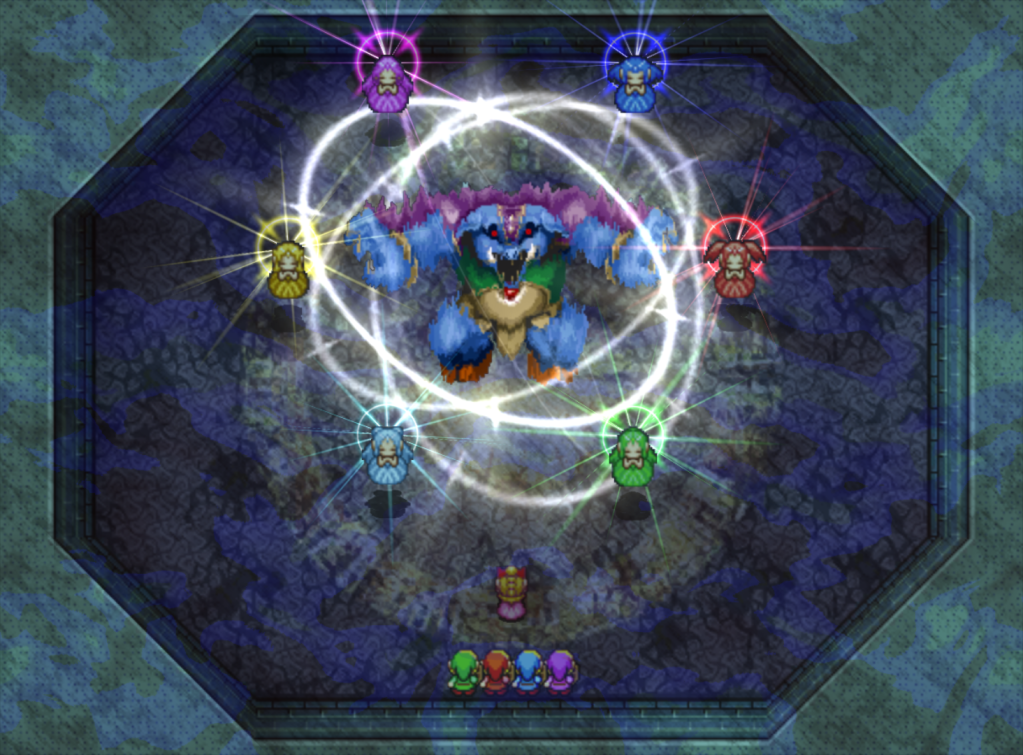Nintendo’s voracious appetite for innovation can lead it to some strange places. From the Super Game Boy onwards the company explored various methods of combining their home and handheld consoles, a long evolution that would eventually result in the world-conquering Switch.
But along the way there were a couple of speedbumps – and The Legend of Zelda: Four Swords Adventures is one of the most notorious. This is a multiplayer focused Zelda with a quest split into 24 discreet stages, covering ‘yer usual Hyrulian territory. The graphics are a tarted up version of A Link to the Past, but there’s also a pinch of The Wind Waker in the animations, effects and enemies.

A top down multiplayer Zelda sounds like a fun time, but there are substantial hurdles to climb over to get there. The biggest is that you can’t play this in multiplayer with GameCube controllers: each player needs to have their own GameBoy Advance and link cable. The idea is that each Link can move between TV and GameBoy independently, with the overworld on the big screen and building interiors and caves displayed on caves.
Thankfully there is a single-player mode that puts both screens on the TV, but as with Four Swords there’s the constant nagging knowledge that you’re not seeing the game as it should be.

But thanks to a very patient girlfriend, I did indeed get to play this in multiplayer. It’s a massive pain in the arse to set up in emulation (you have to sync Dolphin with 4x instances of Virtual Boy Advance), but Reddit user SenerioIX has put together a fantastic wizard that takes a lot of (but not all) the misery out of the process. After some tinkering it worked and we played through the later levels in two-player mode.
Soon after I corralled a further two friends in order to try out four player mode. This is the gold standard of Four Swords Adventures and, despite only playing a handful of the easier levels, was a lot of fun.

But here’s the thing. Sure there’s the considerable hardware (on GameCube) or technical (on emulation) bar to clear, but what most people won’t tell you is that even if you sort all that out, you still need to find three friends who’re a) good at 2D Zelda games, b) will actually stick around for the game’s 15 hour length, and c) won’t just dick around.
You could be forgiven for thinking this would be a chill party game to bust out and thwack some octoroks together with buddies. But, while far from the trickiest Zelda out there, Four Swords Adventures really does require everyone to be on the same page and have a decent level of coordination. But allowing each Link to hit the others and generally cause mischief is too tempting – even for me. I actively wanted to finish the level, but when I see my buddy running with a bomb over his head and I have a flame wand… Well. I’m only human.

If you had the full hardware setup and a four-person team committed to completing the game then this genuinely could be a top flight Zelda title. But the chances of that happening – especially in 2021 – are miniscule. All of which is probably why Four Swords Adventures remains the lowest-selling Nintendo Zelda title by some margin
Given that it’s never been re-released and isn’t often acknowledged I’m betting Nintendo considers this a failed experiment (though it’d be amazing on Switch with online multiplayer). Even so, it’s very easy to trace a development throughline from this game’s dual-screens approach through to the DS and Wii U.

I’m pleased I finally played it, especially that I got to try it four player, but on the whole I’m happy those credits have rolled. Particularly so because up next is The Twilight Princess, which I’ve wanted to play for years.